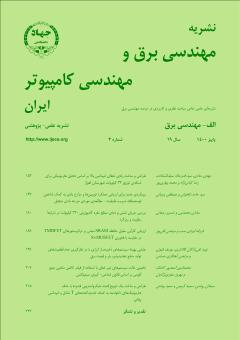ارزیابی کارآیی سلول حافظه SRAM مبتنی بر ترانزیستورهای TMDFET در مقایسه با فناوری Si-MOSFET
محورهای موضوعی : مهندسی برق و کامپیوترفرزانه ایزدی نسب 1 , مرتضی قلی پور 2
1 - دانشگاه صنعتی نوشیروانی بابل
2 - دانشگاه صنعتی نوشیروانی بابل
کلید واژه: 6TSRAM, حافظه دسترسی تصادفی استاتیک, ترانزیستور دی-کلکوژناید فلزات واسطه (TMDFET), تغییرات فرایند, ولتاژ و دما (PVT),
چکیده مقاله :
ترانزیستورهای دی-کلکوژناید فلزات واسطه (TMDFET) از جمله افزارههای نوظهور هستند که در سالهای اخیر مورد توجه محققین قرار گرفته اند. در این مقاله ابتدا اثر تغییر پارامترها، دما و منبع تغذیه بر عملکرد ترانزیستورهای TMDFET در مقایسه با تکنولوژی Si-MOSFET مورد بررسی قرار گرفته است، نتایج بیانگر میزان حساسیت کمتر TMDFET به این تغییرات در مقایسه با افزارهSi-MOSFET است. در ادامه با انتخاب مناسب نسبتهای ابعاد ترانزیستورها، به ارزیابی کارآیی سلول حافظه دسترسی تصادفی استاتیک شش-ترانزیستوری پایه مبتنی بر TMDFET در مقایسه با فناوری Si-MOSFET در تکنولوژی 16nm پرداخته شده است. شبیهسازیها در دمای اتاق، ولتاژ تغذیه 0.7 ولت و شرایط یکسان برای هر دو افزارهTMDFET و Si-MOSFET در نظر گرفته شده است. نتایج حاصل از شبیهسازیها نشان میدهند که SRAM مبتنی برترانزیستورTMDFET دارای 44/29%WTP بیشتر و به همین نسبت توانایی نوشتن بیشتر، 49/49% WTI×WTV بیشتر و به همین نسبت حاشیه نویز نوشتن بالاتر و 48/29% تاخیر خواندن کمتر است.بهعبارتدیگریک سلول SRAM مبتنی بر TMDFET از نظر توانایی نوشتن، حاشیه نویز استاتیکی خواندن وتاخیرخواندن عملکرد بهتری نسبت بهSi-MOS-SRAM از خود نشان میدهد.
Transition metal dichalcogenides FETs (TMDFETs) are among the emerging devices that have been considered by researchers in recent years. In this paper, the effect of parameter variations, temperature and power supply on the performance of TMDFET transistors has been investigated in comparison with Si-MOSFET technology. The results indicate that TMDFET is less sensitive to these variations compared to Si-MOSFET devices. By selecting the appropriate transistors size ratios, the performance of the TMDFET-based conventional 6-transistor static random access memory cell is evaluated in comparison with the Si-MOSFET in 16nm technology. Simulations are performed at room temperature, 0.7 V supply voltage and the same conditions for both TMDFET and Si-MOSFET devices. The results of the simulations show that TMDFET-based SRAM cell has 29.44% more WTP, corresponding to more writing ability, 49.49% more WTI×WTV, corresponding to higher writing noise margin, and 29.48% lower read delay. In other words, a TMDFET-based SRAM cell performs better than Si-MOS-SRAM in terms of write ability, static read margin, and read delay.
[1] J. D. Plummer and B. P. Griffin, "Material and process limits in silicon VLSI technology," Proceedings of the IEEE, vol. 89, no. 3, pp. 240-258, Mar. 2001.
[2] A. A. Kumar and C. Anu, "Performance analysis of 6T SRAM cell on planar and FinFET technology," in Proc. IEEE Int. Conf. on Communication and Signal Processing, ICCSP'19, pp. 0375-0379, Chennai, India, 4-6 Apr. 2019.
[3] P. K. Patel, M. M. Malik, and T. K. Gupta, "Performance evaluation of single-ended disturb-free CNTFET-based multi-Vt SRAM," Microelectronics J., vol. 90, pp. 19-28, Jun. 2019.
[4] E. Abbasian and M. Gholipour, "A variation-aware design for storage cells using Schottky-barrier-type GNRFETs," J. of Computational Electronics, vol. 19, no. 3, pp. 987-1001, 2020.
[5] C. H. Yu, P. Su, and C. T. Chuang, "Impact of random variations on cell stability and write-ability of low-voltage SRAMs using monolayer and bilayer transition metal dichalcogenide (TMD) MOSFETs," IEEE Electron Device Letters, vol. 37, no. 7, pp. 928-931, Jul. 2016.
[6] C. H. Yu, P. Su, and C. T. Chuang, "Performance and stability benchmarking of monolithic 3-D logic circuits and SRAM cells with monolayer and few-layer transition metal dichalcogenide MOSFETs," IEEE Trans. on Electron Devices, vol. 64, no. 5, pp. 2445-2451, May 2017.
[7] M. Gholipour, Y. Y. Chen, and D. Chen, "Compact modeling to device-and circuit-level evaluation of flexible TMD field-effect transistors," IEEE Trans. on Computer-Aided Design of Integrated Circuits and Systems, vol. 37, no. 4, pp. 820-831, Apr. 2017.
[8] A. J. Wilson and A. D. Yoffe, "The transition metal dichalcogenides discussion and interpretation of the observed optical, electrical and structural properties," Advances in Physics, vol. 18, no. 73, pp. 193-335, 1969.
[9] K. S. Novoselov, et al., "Two-dimensional atomic crystals," Proc. of the National Academy of Sciences, vol. 102, no. 30, pp. 10451-10453, 2005.
[10] A. Ayari, E. Cobas, O. Ogundadegbe, and M. S. Fuhrer, "Realization and electrical characterization of ultrathin crystals of layered transition-metal dichalcogenides," J. of Applied Physics, vol. 101, no. 1, Article No.: 014507, 2007.
[11] H. S. S. Ramakrishna Matte, et al., "MoS2 and WS2 analogues of graphene," Angewandte Chemie International Edition, vol. 49, no. 24, pp. 4059-4062, Jun. 2010.
[12] B. Radisavljevic, A. Radenovic, J. Brivio, V. Giacometti, and A. Kis, "Single-layer MoS 2 transistors," Nature Nanotechnology, vol. 6, no. 3, pp. 147-150, 2011.


